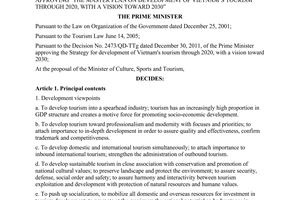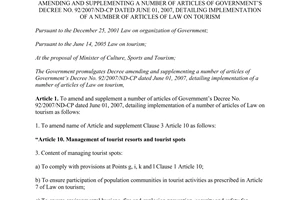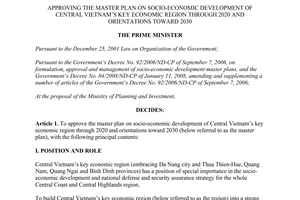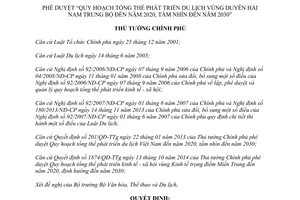Nội dung toàn văn Decision No. 2350/QD-TTg 2014 development in the southern central coast through 2020 2030
|
THE GOVERNMENT |
THE SOCIALIST
REPUBLIC OF VIETNAM |
|
No. 2350/QD-TTg |
Hanoi, December 24, 2014 |
DECISION
APPROVING THE MASTER PLAN ON TOURISM DEVELOPMENT IN THE SOUTHERN CENTRAL COAST THROUGH 2020, WITH A VISION TOWARD 2030
THE PRIME MINISTER
Pursuant to the December 25, 2001 Law on Organization of the Government;
Pursuant to the June 14, 2005 Tourism Law;
Pursuant to the Government’s Decree No. 92/2006/ND-CP of September 7, 2006, formulating, approving and managing the master plan on socio-economic development and the Government’s Decree No. 04/2008/ND-CP of January 11, 2008, amending and supplementing a number of articles of the Government’s Decree No. 92/2006/ND-CP of September 7, 2006;
Pursuant to the Government’s Decree No. 92/2007/ND-CP of June 1, 2007, detailing a number of articles of the Law on Tourism and the Government s Decree No. 180/2013/ND-CP of November 14, 2013, amending and supplementing a number of articles of the Government s Decree No. 92/2007'/ND-CP of June 1, 2007;
Pursuant to the Prime Minister’s Decision No. 201/QD-TTgofJanuary 22,2013, approving the master plan on development of Vietnam’s tourism through 2020, with a vision toward 2030;
Pursuant to the Prime Minister’s Decision No. 1874/QD-TTg of October 13, 2014, approving the masterplan on socio-economic development of the central key economic region through 2020, with a vision toward 2030;
At the proposal of the Minister of Culture, Sports and Tourism,
DECIDES:
Article 1. To approve the master plan on tourism development of the southern central coast through 2020, with a vision toward 2030, with the following principal contents:
1. Geographical position, scale, boundary
The southern central coast (below referred to as the region) embraces Da Nang city and seven provinces of Quang Nam, Quang Ngai, Binh Dinh, Phu Yen, Khanh Hoa, Ninh Thuan and Binh Thuan, covering an area of 44,376.9 km2. Its geographical position is as follows:
- Bordering Thua Thien-Hue province to the north;
- Bordering the East Sea to the east;
- Bordering the Lao People’s Revolutionary Party (LPRP) and Kon Turn, Gia Lai, Dak Lak and Lam Dong provinces to the west; and
- Bordering Dong Nai and Ba Ria-Vung Tau provinces to the south.
2. Development viewpoints
a/ To develop the region’s tourism in conformity with Vietnam’s tourism development strategy and master plan; and the master plan on the socio-economic development of the central key economic region and in alignment with relevant sectoral plans in the region.
b/ To concurrently develop marine-island, cultural and ecological tourism, in which marine-island tourism will be regarded as the spearhead and cultural tourism as the foundation, focusing on Champa and Sa Huynh cultural values, the culture of central coastal residents and ethnic minority groups living on the eastern side of Truong Son mountain range, and relics of the history of the struggles for national construction and defense, to develop typical types of tourism in the region;
c/ To focus on the in-depth development of tourism in the region toward improving quality and professionalism to ensure tourist products with strong brands and high competitiveness.
d/ To closely combine tourism development, assurance of national defense security and environmental protection, to promote linkage between localities in the region to bring into the fullest play the region’s tourism potential and strengths;
dd/ To step up the socialization of tourism development, mobilizing all lawful domestic and overseas funding sources for investment in tourism development.
3. Development objectives
a/ General objectives
To exploit the region’s potential and strengths to develop marine-island tourism into a top strength of national tourism. To develop modem tourism cities and national tourist zones and sites with high-class service establishments.
To develop tourism into an important industry by 2020 and a spearhead industry in the region’s economic structure by 2030, contributing to affirming the national sovereignty and sovereign rights over Vietnam’s sea and islands.
b/ Specific objectives
- Sectoral development targets
+ Tourists: to attract around 15 million tourist arrivals, including around 4.5 million international tourist arrivals, by 2020; and around 25 million tourist aưivals, including around 7.5 million international tourist arrivals, by 2030.
+ Total revenues from tourism will reach around VND 70 trillion, by 2020; and around VND 160 trillion, by 2030.
- Tourist accommodation establishments: There will be more than 95,000 hotel rooms by 2020, with around 15 percent of which reaching the standards of three to five stars; and around 140,000 hotel rooms by 2030, with around 30 percent of which reaching the standards of three to five stars.
- Employment: By 2020, more than 400,000 people (including more than 130,000 directly engaged in tourist activities) will be employed in the industry; and by 2030, this figure will be around 700,000 (including around 230,000 directly engaged in tourist activities).
4. Major development orientations
a/ To concurrently develop domestic and international tourist markets.
- International tourist markets:
+ To attract and strongly develop Northeast Asian markets (Japan, China, the Republic of Korea and Taiwan); Russia and Eastern Europe and Southeast Asian markets;
+ To further exploit traditional markets such as Western Europe, Northern Europe, North America and Oceania;
+ To expand new markets: India, Turkey and the Middle East.
- Domestic tourist markets:
+ To strongly develop intra-regional tourist markets and the market of tourists coming from Hanoi, Ho Chi Minh City and central highlands provinces; and to attach importance to tourists who travel for leisure, recreation, weekend rests, spiritual purposes or shopping;
+ To encourage the development and expansion of specialized tourism and business tourism.
b/ To exploit the region’s potential and advantages to develop highly competitive and attractive tourist products; to attach importance to improving the quality of travel, accommodation, catering and recreation and entertainment services.
- To prioritize the development of groups of main products:
+ Group of marine tourist products;
+ Group of tourist products linked with the world cultural heritage sites.
- To diversify tourist products and auxiliary products such as convention tourism; cruise tourism; marine sports tourism; marine eco-tourism; nature exploration tourism; sightseeing tourism; cuisine tourism; urban tourism; convalescence and beauty service tourism, community tourism, rural and agricultural tourism; festival and spiritual tourism.
c/ Organization of tourism development space
- Tourism development space
+ The northern tourism sub-region, embracing Da Nang city and Quang Nam, Quang Ngai and Binh Dinh provinces: To exploit typical tourist products, including tours to the world cultural heritage sites linked with Hoi An Ancient Town and My Son Sanctuary, Champa and Sa Huynh cultural values, tours to historical relics associated with the struggles for national construction and defense; marine-island leisure; convention; ecology, recreation and entertainment, sports, weekend rests; festivals and spiritual sites.
+ The southern tourism sub-region, embracing Phu Yen, Khanh Hoa, Ninh Thuan and Binh Thuan provinces: To exploit typical tourist products, including marine-island leisure; cultural tourism associated with Champa group’s cultural values, the culture of ethnic minority groups living on the eastern side of Truong Son mountain range; agricultural and rural ecology; festivals and spiritual sites.
- Tourist zones, tourist sites, tourist cities and tourist centers
+ To focus investment on developing nine national tourist zones, namely Son Tra, Ba Na (Da Nang), Cu Lao Cham (Quang Nam), My Khe (Quang Ngai), Phuong Mai (Binh Dinh), Vinh Xuan Dai (Phu Yen), Northern Cam Ranh (Khanh Hoa), Ninh Chu (Ninh Thuan) and Mui Ne (Binh Thuan); six national tourist sites, namely Ngu Hanh Son (Da Nang), My Son (Quang Nam), Ly Son (Quang Ngai), Truong Luy (Quang Ngai, Binh Dinh), Truong Sa (Khanh Hoa) and Phu Quy (Binh Thuan); and four tourist cities, namely Da Nang city, Hoi An city (Quang Nam), Nha Trang city (Khanh Hoa) and Phan Thiet city (Binh Thuan).
+ Tourist centers: To develop Da Nang city into a tourist center of the region and the northern tourism sub-region; Nha Trang city (Khanh Hoa) into a tourist center of the southern tourism sub-region and the region’s auxiliary center; and Quy Nhon city (Binh Dinh) into an auxiliary center of the northern tourism sub-region and Phan Thiet city (Binh Thuan) into an auxiliary center of the southern tourism sub-region.
- Tourist routes
+ Intra-regional tourist routes:
Major tourist routes include national highways linking regional tourist centers, subregional centers, local tourist centers and tourist zones and sites in the region.
Auxiliary tourist routes are tourist routes linking sub-regional tourist centers, local tourist centers, tourist cities and adjacent tourist sites in the sub-regional space.
Based on the system of the intra-regional routes to open and operate specialized tours such as marine ecology to explore the sea and coastal and off-shore islands, countryside tours to rural and agricultural trade villages, and river tourism.
+ The inter-regional tourist route by land, railway, waterway and air linking Central Highlands provinces; the southeastern region and southern provinces; and the northern central region and northern provinces.
Based on the inter-regional tourist route, to further operate specialized tourist routes such as the “ASEAN Heritage Path” linking the “Green Path of the Central Highlands” and the “Legendary Ho Chi Minh Trail” and tours to the Champa group’s historical and cultural relics.
+ To develop national tourist routes based on the expansion of inter-regional tourist routes linking with international airports, including Da Nang, Cam Ranh (Khanh Hoa) and Chu Lai (Quang Nam); the trans-Asia railway and land routes; national highways 1A, 9 and 19 on the East-West Corridor connected with the international land border gates of Lao Bao (Quang Tri), Cha Lo (Quang Binh), Bo Y (Kon Turn), and Le Thanh (Gia Lai) and the waterway route via the seaports of Tien Sa (Da Nang), Quy Nhon (Binh Dinh), Nha Trang and Cam Ranh (Khanh Hoa).
d/ Tourism development investment
- Investment capital from the budget (including ODA), FDI capital, capital raised from domestic organizations, enterprises and economic sectors and other lawful sources. Investment capital from the state budget shall be allocated based on the annual budget balance capacity and schedule in each period.
- Investment programs and projects: To prioritize investment in developing nine national tourist zones and six national tourist sites in the region. To invest in four tourism development programs on training and development of human resources; promotion, advertising and branding of the region’s tourism; preservation, embellishment and development of natural resources; and development of key tourism infrastructure.
5. Solutions for implementation of the master plan
a/ Mechanisms and policies
To study, complete and apply the system of specific mechanisms and policies for tourism development investment, development of high-quality human resources for tourism, market development, socialization of tourism, development associated with conservation and sustainable development and inter-regional and inter-sectoral coordination mechanism.
b/ Investment in tourism development
- To increase, and improve the effectiveness of, state budget investment in tourism development toward prioritizing the development of tourist zones’ infrastructure, integrating tourism development into national target programs; further mobilizing ODA capital and borrowing foreign concessional loans or issuing government bonds for major projects such as airports, expressways and tourist ports, making use of international assistance to attract funding for long-term development programs.
- To mobilize to the utmost various capital sources; making the fullest use of financial sources from the population and the financial potential of domestic and overseas organizations to ensure other sufficient capital sources for tourism development.
c/ Development of human resources for tourism
- To develop human resources for tourism to be sufficient in quantity, balanced in trained jobs and training levels and good in quality to meet the requirements of the region’s high-class tourism and sustainable development.
- To concretize the master plan on development of human resources for tourism in the region via human resources development plans and programs tailored to each locality’s tourism development demand.
- To focus on building a contingent of lecturers, trainers and appraisers for the tourism profession, and renewing training contents, programs and methods; to increase on-the-spot training to meet the requirements of each locality’s human resources development and the requirements of international integration.
- To formulate programs and plans to raise public awareness about tourism and the protection of natural resources and the tourism environment.
d/ Cooperation and linkage in tourism development
- To increase opportunities and create a favorable and equal environment for linkage among localities in the region.
- To ensure close linkage in tourism development investment, formulating regional tourism programs, developing linkage in tourism advertising and promotion and in human resources training and development.
- To build a model of linkage specifying the role and tasks of each party, including the central tourism management agency, local authorities, and tourism businesses and associations.
- To enhance cooperation and linkage among localities in the region, with other regions and localities nationwide; between tourism and relevant industries and sectors, especially with the public security and border guard forces, to ensure safety for tourists, contributing to maintaining social order and safety and national security.
- To enhance international cooperation in tourism development to contribute to safeguarding national sovereignty and territorial integrity.
dd/ Management of planning
- To promote the coordination and collaboration in tourism state management between central and local levels:
+To continue upholding the role of local Steering Committees for Tourism Development, particularly of the State Steering Committee on Tourism, in inter-sectoral and inter-provincial coordination.
+ To coordinate planning work and planning management, management of natural resources and development of human resources for tourism.
- To implement decentralization in a thorough and uniform manner: the central state management agency of tourism shall perform management based on the industry’s standards, regulations and norms; localities in the region shall directly manage natural resources and develop tourism according to the industry’s plan, the construction master plan approved by competent authorities and specialized standards and regulations.
e/ Tourism promotion and advertising
- To increase resources for tourism promotion and advertising: to increase budget funds for promotion, advertising and branding of the region’s tourism; to boost public information on the socialization to mobilize resources for tourism promotion and advertising.
- To raise the professionalism in tourism promotion and advertising activities: To concentrate efforts on carrying out tourism promotion and advertising campaigns in different forms in the country and overseas; to effectively utilize means of communication and involve overseas Vietnamese diplomatic representative missions in tourism promotion and advertising.
- To regularly assess the region’s tourism potential and development situation to fully and accurately update information to serve tourism promotion and advertising activities.
g/ Marketing and branding
- To formulate a strategy on tourist markets and create market development mechanisms and policies to prioritize the development of adjacent markets, maintain traditional markets and look toward new markets to develop tourism in a stable and sustainable manner; to regularly explore markets to grasp their characteristics and tastes so as to draw up suitable tourist product development plans.
- To diversify tourist products according to each sub-region and locality; to mobilize all economic sectors to invest in creating tourist products, contributing to raising the effectiveness of the socialization of tourism development; to strongly develop specialized tourist products to increase tourists’ length of stay.
- To combine raising the quality of tourist products and developing the region’s highly competitive typical tourist products toward developing the “marine leisure” brand into the region’s typical tourist brand.
h/ Protection of natural resources and the tourist environment and response to climate change
- To implement education and public information activities to raise awareness about the role and significance of natural resources and the environment in tourist activities.
- To apply technical advances to controlling environmental issues, managing natural resources and developing tourism.
- To encourage environment-friendly tourist activities, to encourage and support local communities in investing in tourist development, sharing benefits and responsibilities in exploiting natural resources for tourism development.
- To raise awareness and increase the adaptability and response to climate change and sea level rise in the region’s tourist activities.
Article 2. Organization of implementation
1. The State Steering Committee on Tourism
The State Steering Committee on Tourism shall direct ministries, central sectors and localities in the region in dealing with inter-sectoral and inter-provincial issues arising the course of implementing the master plan.
2. The Ministry of Culture, Sports and Tourism
a/ To organize the announcement and implementation of the master plan;
b/ To assume the prime responsibility for formulating and implementing master plans on development of national tourist zones and sites bearing inter-provincial characteristics or holding a significant role in the region’s defense and security;
c/To coordinate with other ministries, sectors and provincial-level People’s Committees in the region in performing relevant tasks in all tourist activities; to review and complete mechanisms and policies to encourage and call for investment in building a physical infrastructure system and training human resources for the region’s tourism on the basis of the list of prioritized investment project promulgated together with this Decision;
Based on the practical implementation of the master plan, the Ministry of Culture, Sports and Tourism and provincial-level People’s Committees in the region may agree on the change of names and decide on adding or reducing prioritized investment projects.
d/ To draw up, and organize the implementation of, action plans for tourism development for every five-year period in line with the orientations of the region’s tourism development master plan;
dd/ To formulate, and organize the implementation of, culture and sports policies, master plans, programs, schemes and projects in line with the orientations of the region’s tourism development master plan;
e/ To guide localities in the region to formulate their local tourism development master plans and master plans on local tourist zones and sites.
g/ To conduct annual preliminary reviews and propose policies and solutions to adjust the master plan to suit reality; and report them to the Prime Minister.
3. Ministries, ministerial-level agencies and government-attached agencies shall, within the scope of their functions, tasks and powers, coordinate with the Ministry of Culture, Sports and Tourism in implementing the regional development master plan, specifically:
- Advising the Government and the Prime Minister on the integration of national target programs and sectoral action plans into the region’s tourism development master plan;
- Assuming the prime responsibility for formulating sectoral programs and action plans to implement their assigned tasks in the region’s tourism development master plan.
- Effectively coordinating with the Ministry of Culture, Sports and Tourism in settling inter-sectoral matters.
4. Provincial-level People’s Committees in the region
To coordinate with the Ministry of Culture, Sports and Tourism and relevant ministries and sectors in performing the following tasks:
- To take the initiative in implementing and expanding linkage among localities in the region in promotion and advertising activities to attract tourists and call for investment in tourism;
- To encourage local businesses to develop typical tourist products for the region; to facilitate enterprises’ linkage and cooperation with localities in the region to develop tourism;
- Based on the contents of the regional tourism master plan, to formulate tourism development master plans, detailed plans and investment projects conformable to and associated with local socio-economic development master plans in the region;
- To direct and manage the protection of natural resources and the tourism environment, especially for zoned-off national tourist zones and sites;
- To attach importance to traffic safety and order so as to increase safety for tourists and promote the regional and local tourist image;
- To educate local people on preserving and upholding the values of tourist resources toward sustainable development;
- To socialize tourism development in order to bring into play the strength of all economic sectors in tourism development;
- Based on the master plan’s research results, to set up a channel for regular information exchange among different managerial levels in the region to direct and guide tourist businesses and investors in closely following the common development thoughts of the whole region;
- To inspect and examine tourism investment, development and exploitation activities.
5. Tourism businesses and associations and mass organizations and other socio-political organizations
- Based on the region’s master plan on tourism development, businesses shall take the initiative in allocating funds for elaborating and implementing detailed plans on tourist zones and sites and tourism development investment projects.
- Tourism associations and other social organizations shall, within the ambit of their functions and operation, grasp and concretize the objectives, viewpoints and orientations of the master plan into their action plans.
- Mass organizations and socio-political organizations shall coordinate with the tourism industry and local authorities in the region in promoting the region’s tourist image; mobilize and educate local people to raise their awareness about tourism, tourism planning and protection of natural resources and tourist environment.
- Local communities shall actively participate in tourist activities such as provision of community tourism services, conservation and sustainable exploitation of natural resources and protection of the tourist environment under tourism development master plans.
Article 3. This Decision takes effect on the date of its signing.
Article 4. Ministers, heads of ministerial-level agencies, heads of government-attached agencies and chairpersons of provincial-level People’s Committees of Da Nang, Quang Nam, Quang Ngai, Binh Dinh, Phu Yen, Khanh Hoa, Ninh Thuan, and Binh Thuan shall implement this Decision.
|
|
FOR THE PRIME
MINISTER |
APPENDIX
LIST OF PRIORITIZED INVESTMENT PROJECTS
(To the Prime Minister’s Decision No. 2350/QD-TTg of December 24, 2014)
|
No. |
Name of project |
Implementation phases |
|
|
I |
Investment in developing national tourist zones |
||
|
1 |
Son Tra tourist zone (Da Nang) |
To 2020 |
2021-2030 |
|
2 |
Ba Na tourist zone (Da Nang) |
|
2021-2030 |
|
3 |
Cu Lao Cham tourist zone (Quang Nam) |
To 2020 |
|
|
4 |
My Khe tourist zone (Quang Ngai) |
|
2021-2030 |
|
5 |
Phuong Mai tourist zone (Binh Dinh) |
To 2020 |
|
|
6 |
Xuan Dai Bay tourist zone (Phu Yen) |
|
2021-2030 |
|
7 |
Northern Cam Ranh tourist zone (Khanh Hoa) |
To 2020 |
2021-2030 |
|
8 |
Ninh Chu tourist zone (Ninh Thuan) |
To 2020 |
2021-2030 |
|
9 |
Mui Ne tourist zone (Binh Thuan) |
To 2020 |
|
|
II |
Investment in developing national tourist sites |
||
|
1 |
Ngu Hanh Son tourist site (Da Nang) |
To 2020 |
|
|
2 |
My Son tourist site (Quang Nam) |
To 2020 |
|
|
3 |
Ly Son tourist site (Quang Ngai) |
To 2020 |
|
|
4 |
Truong Luy tourist site (Quang Ngai, Binh Dinh) |
|
2021-2030 |
|
5 |
Truong Sa tourist site (Khanh Hoa) |
|
2021-2030 |
|
6 |
Phu Quy tourist site (Binh Thuan) |
To 2020 |
2021-2030 |
|
III |
Regional tourism development programs |
||
|
1 |
Human resources development |
To 2020 |
2021-2030 |
|
2 |
Promotion, advertising and development of regional tourist brands |
To 2020 |
2021-2030 |
|
3 |
Conservation, embellishment and development of natural resources |
To 2020 |
2021-2030 |
|
4 |
Development of key tourist infrastructure |
To 2020 |
2021-2030 |
Note: The sizes and land areas of tourist zones and sites and total investment amounts for the above projects will be calculated, selected and specified in the stages of formulation and submission of investment projects, depending on the capacity of balancing and raising investment capital in each period.-






